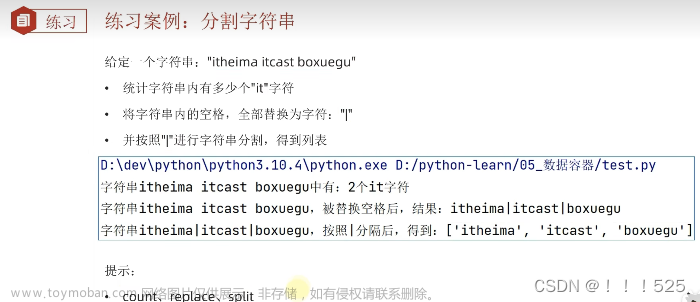在开发过程中,很多时候我们有分割字符串的需求,即把一个字符串按照某种分割符进行切割。
在 Go 语言中,分割字符串我们可以分为几种情况,分别为:
- 按空格分割
- 按字符分割
- 按字符串分割
下面分别讲解使用 Golang 如何实现不同方式的字符串分割。
1.按空格分割
ss := strings.Fields(s)
示例:
package main
import (
"fmt"
"strings"
)
func main() {
fmt.Printf("Fields are: %q", strings.Fields(" foo bar baz "))
}
输出:
Fields are: ["foo" "bar" "baz"]
2.按字符/字符串分割
ss := strings.Split(s, sep)
可以指定一个字符串作为分隔符,可以指定单个字符作为分隔符,因为单个字符也是一个字符串。
示例:
package main
import (
"fmt"
"strings"
)
func main() {
fmt.Printf("%q\n", strings.Split("a,b,c", ","))
fmt.Printf("%q\n", strings.Split("a man a plan a canal panama", "a "))
fmt.Printf("%q\n", strings.Split(" xyz ", ""))
fmt.Printf("%q\n", strings.Split("", ","))
}
输出:
["a" "b" "c"]
["" "man " "plan " "canal panama"]
[" " "x" "y" "z" " "]
[""]
注意,如果待分割串为空串,strings.Split 将返回包含一个空串的切片。
如果希望返回 nil 切片,可以做一下封装。
func Split(s, sep string) []string {
if s == "" {
return nil
}
return strings.Split(s, sep)
}
3.按多个字符分割
标准库 strings 包中有一个函数 FieldsFunc 可以指定多个字符为分隔符。
ss := strings.FieldsFunc(s,f func(rune) bool)
示例:
package main
import (
"fmt"
"strings"
"unicode"
)
func main() {
f := func(c rune) bool {
return !unicode.IsLetter(c) && !unicode.IsNumber(c)
}
fmt.Printf("Fields are: %q", strings.FieldsFunc(" foo1;bar2,baz3...", f))
}
输出:
Fields are: ["foo1" "bar2" "baz3"]
4.按多个字符串分割
截至 Go 1.20,标准库暂未供支持多个字符串作为分隔符的分割函数。但是,我们可以基于 strings.Split 编写一个函数来实现这个功能。
// SplitSeps splits string into substring slice by multiple string separators.
// If you want to specify multiple string separators by regexp,
// please refer to `func (*Regexp) Split` in standard library regexp package.
func SplitSeps(s string, seps ...string) []string {
if len(seps) == 0 {
return []string{s}
}
result := strings.Split(s, seps[0])
for _, sep := range seps[1:] {
var temp []string
for _, r := range result {
temp = append(temp, strings.Split(r, sep)...)
}
result = temp
}
return result
}
示例:
package main
import (
"fmt"
"strings"
)
func main() {
fmt.Printf("%q\n", SplitSeps("foo,bar,baz", []string{","}...))
fmt.Printf("%q\n", SplitSeps("foo,bar|baz", []string{",", "|"}...))
fmt.Printf("%q\n", SplitSeps("foo,bar|baz qux", []string{",", "|", " "}...))
fmt.Printf("%q\n", SplitSeps("foo,bar|bazSEPqux", []string{",", "|", "SEP"}...))
fmt.Printf("%q\n", SplitSeps("foo,bar|baz", []string{}...))
fmt.Printf("%q\n", SplitSeps(" xyz", []string{""}...))
}
输出:
["foo" "bar" "baz"]
["foo" "bar" "baz"]
["foo" "bar" "baz" "qux"]
["foo" "bar" "baz" "qux"]
["foo,bar|baz"]
[" " "x" "y" "z"]
5.其他分割函数
除了文中提及的标准库函数,你可能还会用到下面这几个标准库函数控制字符串的分割方式。
- strings.SplitN
func strings.SplitN(s, sep string, n int) []string
该函数与 Split 函数类似,但是可以指定分割后的最大子字符串个数 n,如果 n 为正数,则最多分割成 n 个子字符串;如果 n 为负数,则不限制子字符串个数。例如:
str := "hello,world,how,are,you"
words := strings.SplitN(str, ",", 2)
fmt.Println(words) // ["hello", "world,how,are,you"]
- strings.SplitAfter
func SplitAfter(s, sep string) []string
该函数将字符串 s 按照分割符 sep 分割成多个子字符串,并返回一个字符串切片。不同于 Split 函数的是,SplitAfter 函数会在分割符之后分割,例如:
str := "hello,world,how,are,you"
words := strings.SplitAfter(str, ",")
fmt.Println(words) // ["hello,", "world,", "how,", "are,", "you"]
- strings.SplitAfterN
func SplitAfterN(s, sep string, n int) []string
该函数与 SplitAfter 函数类似,但是可以指定分割后的最大子字符串个数 n。如果 n 为负数,则不限制子字符串个数。例如:
str := "hello,world,how,are,you"
words := strings.SplitAfterN(str, ",", 2)
fmt.Println(words) // ["hello,", "world,how,are,you"]
6.dablelv/cyan
借助 Golang 标准库提供的相关函数,分割字符串还是比较方便的。
文中提及的两个函数,已放置 Github 开源工具库 dablelv/cyan,大家可使用 go mod 方式 import 后使用。
import "github.com/dablelv/cyan/str"
// Split 如果待分割串为空串,返回 nil 切片而非包含一个空串的切片。
str.Split(s, sep string) []string
// SplitSeps 通过多个字符串分隔符将字符串分割为字符串切片。
str.SplitSeps(s string, seps []string) []string
dablelv/cyan 除了类型转换,还有很多其他实用函数,如加解密、zip 解压缩等,欢迎大家使用、Star、Issue 和 Pull Request。文章来源:https://www.toymoban.com/news/detail-460073.html
参考文献
strings - Go Packages
8 ways to split a string in Go (Golang) - GOSAMPLES
github.com/dablelv/cyan
OpenAI ChatGPT文章来源地址https://www.toymoban.com/news/detail-460073.html
到了这里,关于Golang 分割字符串的文章就介绍完了。如果您还想了解更多内容,请在右上角搜索TOY模板网以前的文章或继续浏览下面的相关文章,希望大家以后多多支持TOY模板网!








